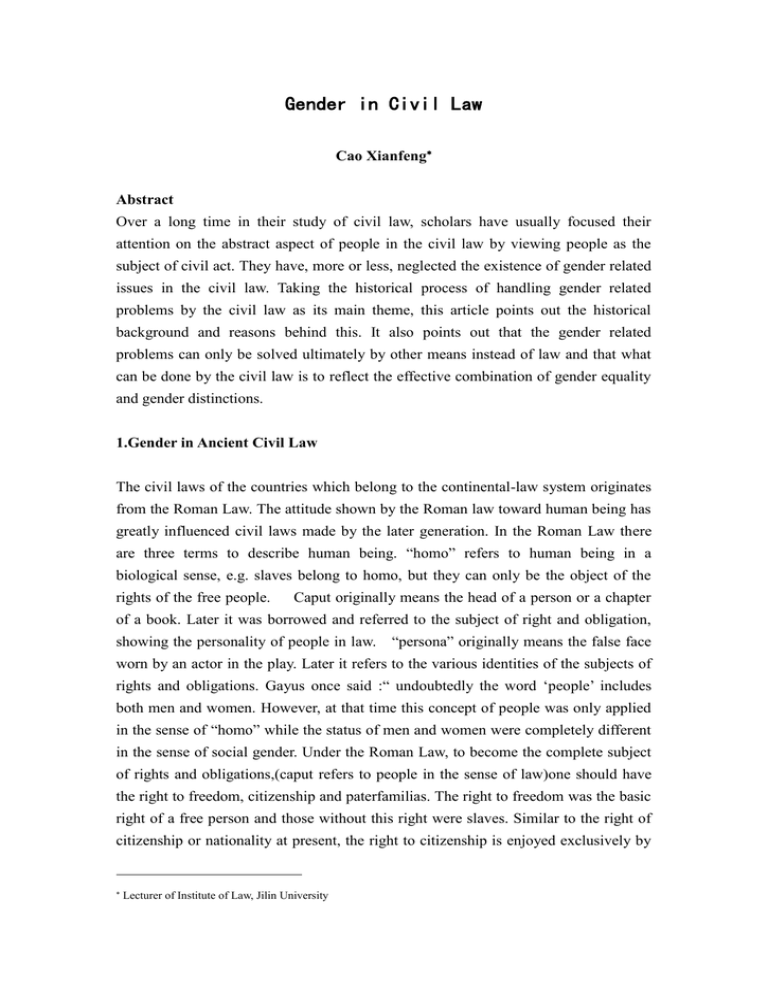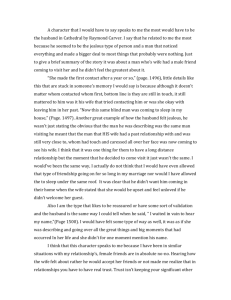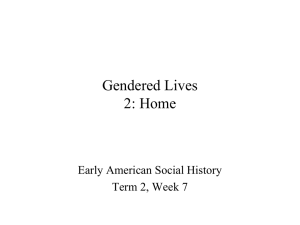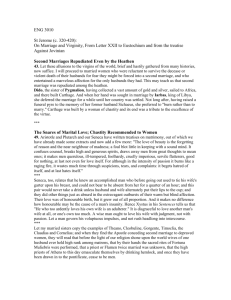cao xianfeng-eng
advertisement

Gender in Civil Law Cao Xianfeng Abstract Over a long time in their study of civil law, scholars have usually focused their attention on the abstract aspect of people in the civil law by viewing people as the subject of civil act. They have, more or less, neglected the existence of gender related issues in the civil law. Taking the historical process of handling gender related problems by the civil law as its main theme, this article points out the historical background and reasons behind this. It also points out that the gender related problems can only be solved ultimately by other means instead of law and that what can be done by the civil law is to reflect the effective combination of gender equality and gender distinctions. 1.Gender in Ancient Civil Law The civil laws of the countries which belong to the continental-law system originates from the Roman Law. The attitude shown by the Roman law toward human being has greatly influenced civil laws made by the later generation. In the Roman Law there are three terms to describe human being. “homo” refers to human being in a biological sense, e.g. slaves belong to homo, but they can only be the object of the rights of the free people. Caput originally means the head of a person or a chapter of a book. Later it was borrowed and referred to the subject of right and obligation, showing the personality of people in law. “persona” originally means the false face worn by an actor in the play. Later it refers to the various identities of the subjects of rights and obligations. Gayus once said :“ undoubtedly the word ‘people’ includes both men and women. However, at that time this concept of people was only applied in the sense of “homo” while the status of men and women were completely different in the sense of social gender. Under the Roman Law, to become the complete subject of rights and obligations,(caput refers to people in the sense of law)one should have the right to freedom, citizenship and paterfamilias. The right to freedom was the basic right of a free person and those without this right were slaves. Similar to the right of citizenship or nationality at present, the right to citizenship is enjoyed exclusively by Lecturer of Institute of Law, Jilin University Roman citizens. The right of paterfamilias concerned the division of rights and obligations within a Roman family. Those who enjoyed this right was called “ paterfamilias” referring to people with the identity of free person and Roman citizenship but without any superior male lineal relatives alive. The “paterfamilias” is not only the subject of rights under the civil law of the city who has social freedom, but also not dominated by any authorities from the family while fully enjoying the various rights related to the family’s properties and personal rights. Max once said:” The head of a Roman family enjoys the absolute right to everything within the scope of family finance.” As alieni juris, women were directly dominated by paternal power. Although the wife of the paterfamilias or the women independent of paternal power could be sui juris, the wife of the paterfamilias was still under the authority of the father, only with “materfamilias” as an honor. As to women breaking away from the paternal power, the law should not grant to them any rights to free people. 1As for marital relations, the laws in earlier times adopted the doctrine of conjugal integration, providing that the wife’s dignity should be absorbed by her husband and the wife’s estate should be possessed by her husband or the head of the family. From this we can see that although the early Ius Privatum enjoys the reputation of “ the first worldwide law in the commodity society”, its attitude toward women is typically unfair and unequal. What are in-depth reaosns behind this inequality? In my opinion, the Roman society is a typical identity-oriented society, granting the right to freedom and citizenship to all of its residents and granting family right to all the internal organizations within the family. The former one is macro and related to public law, the latter is a micro and related to private law. The interaction of the two factors formed the following situation: Clearly-defined classes(a division between slaves and masters), well-maintained order within the family(a clear division between the paterfamilias and ), different attitudes toward people within and outside the city(division between foreigners and Roman citizens), protection for children and women(the father’s function in safeguarding children and women) and life support for the young and the weak(guardianship and guarantee) 2By distinguishing the legal person from the natural person, the Roman Law established a legal system aiming to maintain the rule of slave-holders. In this legal system, the female citizen is put under the domination of the male(her male lineal relatives in particular) including the identity relations, property relations and the possession of the status of a subject , etc. without any exceptions. At the same time, by distributing power within family and taking account of the requirement for other identities, the Roman Law not only identified the order in the private law but also the order in the public law. From then on, despite the church law period, the development of civil law on the whole followed the Roman Law provisions so as to consolidate the relevant orders in both the public and private laws through the domination of male over female within families. 2.Gender in Modern Civil Laws With the historical progress “from identities to contracts”, the views on gender in civil laws has witnessed dramatic changes which haven’t taken place overnight. Instead of taking place simultaneously in both property and personal field, these changes first took place in the property field. The great changes in personal field have become very important in distinguishing modern civil law from the neoteric one. The subject system of the ancient Roman society was designed to maintain the authority of the paterfamilias and the order of communities. Therefore the super-individualism took the dominant role in the society. However, as trade was started, individuals contacted frequently one another and began to ask for individual independence. This made the lawmakers to think more about individual independence and lead to the appearance of individualism. As a result, the civil laws shifted the consideration from family as a basic unit to individual as a basic unit. This demand for changes has developed into a great force behind the legal and social reforms. The revolution of the western world from 1776 resulted in tremendous social changes with the bourgeoisie coming to power. The Napoleonic Code is the watershed between the ancient and neoteric civil laws. “The series of Napoleon’s legislations show economic liberalism and philosophical individualism and take reason of the natural law as the principle of legislation.” 3 In the 17th century, proceeding from the supposed individual in natural state, Hobbes and Locke proposed two social contracts forming the social basis and put the theory of individual right onto the stage of thoughts, facilitating the transition of European political and legal structures in the 18th century. At the same time, this supposed theory of individual right , together with the bourgeois activities formed the thought of individual freedom in political economics. In the 18th century, Aden Smith imagined a free economic lifestyle for individuals, holding that everybody enjoys the freedom of properly pursuing happiness in his own way and may compete with other people or organizations with his own hard-work and asset. The individualism found its economic purpose and promoted the economic prosperity. Therefore going hand in hand with individual free economy and taking market as the core concept, the individualism embraced the 19th century --- its most prosperous period. Meanwhile, the rationalism generated by the principle of natural law became the leading thought in the revolution period and was employed to implement the theory of personal freedom generated by stressing the human right in the revolution period. Responding to the identity dependence of the feudal system, people felt urgent to put an emphasis on their right to property. 4The revolution realized the historical change “from identity to contract” which was set by the Napoleonic Code and the relevant legislations. The three principles of the bourgeoisie ---the sacred right of ownership, self-governance of thought and liability for fault—formulated by the French Civil Law just reflected the essential need of human being. Following the establishment of these principles, the competitive environment required by economic freedom in the economic field changed the dominating role of the family in the ancient times and help the individuals step out of their families, giving great impetus to the development of the capitalist economy. However, unlike in the property field, gender discrimination was not eliminated in the family field. In Napoleon Law, “Although the hierarchical privilege disappeared, sex privilege which some French revolutionaries want to eliminate was still preserved. 5 The Civil Law of Napoleon provided that:” the husband should protect his wife while the wife should obey her husband.” It also provided that without her husband’s permission, the wife should not file an action, grant, transfer and impawn the property. The 1900 German Civil Code was much more improved than the early French Civil Law, however, it still provided:” the husband is entitled to decide all the marriage affairs, if the wife disposes her personal marital property without the permission of her husband, her behavior of this kind will be considered invalid. With the development of the commodity economy in capitalist society and the readjustment to capitalist system, especially under the great pressure of the ever-increasing women’s movement, the laws on conjugal relations in western capitalist countries showed a development tendency toward equality between husband and wife. In fighting against the feudal system, the bourgoisie put forward “theory of marriage contract” which acknowledged the equality between husband and wife in marriage. In terms of conjugal relations, they advocated the doctrine of conjugal separation, which is a historical progress. Take Britain as an example, its 1882 Law Of Property of Married Women recognized the right of personal property for husband and wife by providing that women could enjoy a series of property rights. The law in 1907 further provided that the wife could transfer her personal property without permission of her husband. The 1935 Law On Marriage Reform identified women’s ability to acquire, possess and dispose any property, the ability to assume the accountability for all the infringement act, contract obligations and debt payment and the ability to file an action and responding to an action. The other countries share the same process despite their different pace of development. The vigorous development of women’s movement and the rise of feminism aroused worldwide attention to gender discrimination, hence the demand for gender equality was gradually reflected in civil laws, in marriage law, in particular. For example, the law approved in July13, 1965 in France revised the whole chapter named the Mutual rights and Obligations of Husband and Wife in the civil code. It provided: “both husband and wife are entitled to complete legal right”, “both sides may open an account in banks and stock exchanges without permission from the other side” and “ the wife has the right to engage in a job without the permission of her husband”. In the conservative Britain, 80 family laws and decrees have been issued since the end of 1940s in order to practicing the principle of equality between husband and wife. In the Japanese Civil Code, a second clause was added to article 1 of the Law 222, which says:“ this law should be interpreted in accordance with the principle of individual personality and gender equality”. In December 18, 1979, the General Assembly of the U.N. approved Convention on the Elimination of All Forms of Discrimination against Women which requires all the contracting parties to grant equality before the law to both men and women. It stresses :“ various measures should be taken to eliminate the discriminations against women in all the affairs related to marriage and family relation”. All these show that modern civil law’s awareness of gender discrimination has developed into a high degree. From the practice of bourgeoisie legislation in history we can see that it adopts different attitudes toward property field and personal field. It at least shows that the legislation identifies personal freedom and equality before the law for everybody from the economic perspective, which was the basic need of the capitalist economic development. ---“from identity to contract” is a brief summary of the legislative demand of the bourgeoisie in the competition. However, in the marriage and family field relatively far from the property field, people’s demand for equality can only be met through women’s movement instead of by seeking help from the economic foundation. Perspectives of feminism The provisions about gender equality in the modern civil law were much more advanced than those in the past. But they still can’t provide satisfactory solutions to the problem of gender discrimination. In his article named Family in Transition, Saridven Robots, head of the British Family Policy Research Center, points out that although the employment situation of married women has been getting better in the past two decades, in only 22% of the families with children, both husband and wife have full-time jobs. Therefore, “today women in three fourths of the families are still engaged in most of the household chores.” Against this background, it is not surprising that today one fourth of women are subject to physical or mental maltreatment and over 45000 women and children seek refuge so as to avoid domestic violence. We can borrow ideas from the western feminism in terms of the legal understanding and settlement of the problem of gender discrimination. The western feminism’s understanding of and pursuit for gender equality has experienced three stages: first, pursue gender discrimination regardless of gender differences. The major representative school of this period was feminism of liberalism. Second, pursue the different treatments on the basis of gender differences. The major representative school of this period was feminism of activism. Third, put an emphasis on understanding gender differences in a dynamic way. The post-modern feminism was the major school of this period. The concepts in the first two stages are more or less reflected by laws. For example, the first one is reflected by equality between husband and wife in exercising parental power and disposing property while the second is reflected by the restrictions on the husband’s right to matrimonial action in the Marriage Law of China. Meanwhile, the idea of post- modern feminism deserves more reflection in that it can help us to explain why both the interpretation of taking gender equality as regardless of gender difference and the interpretation of taking gender equality as valuing gender difference are not adequate in a dynamic manner. This dynamic way can not only shows us why the negligence of gender difference may be unjust and may lead to further inequality in reality but also points out the importance of social factors resulting in gender difference. However, it also points out the potential dangers in putting too much emphasis on gender difference. It makes us aware that the ever-increasing equality between husband and wife before the law is no doubt a progress, however this kind of equality will only an equality in name if the political and economic status of men and women are not changed and if the people’s ideology is not altered. As for civil law, how to draw a clear line between equality of men and women while recognizing gender differences deserves a brown study. In my opinion, the conjugal right provided by the marriage law of China may be taken as a successful example in this regard.






